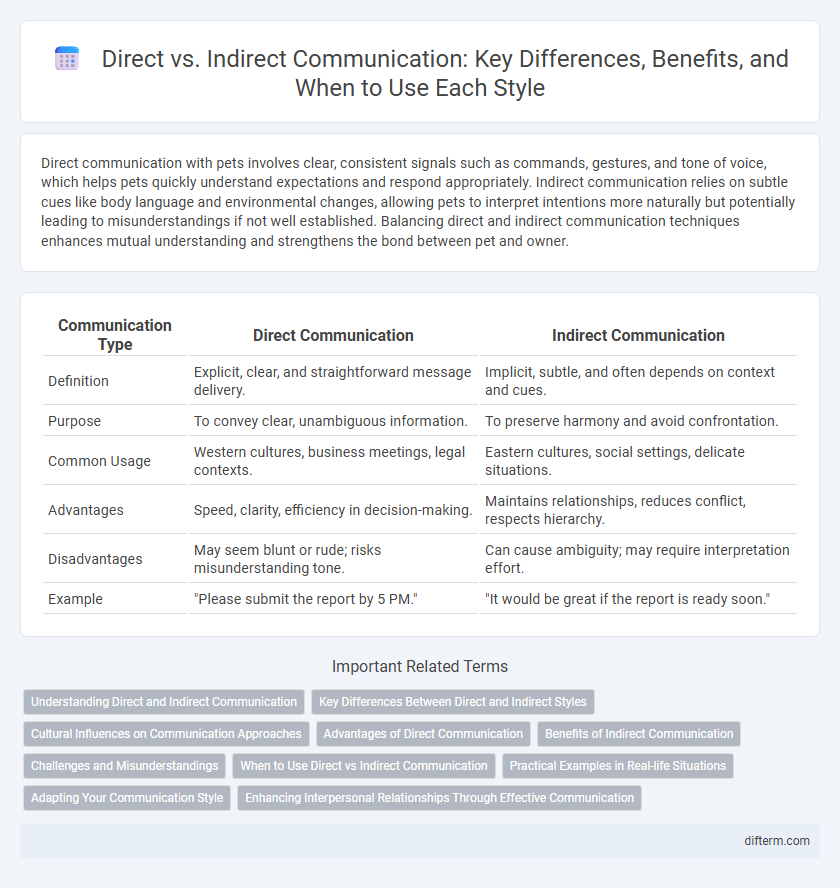Direct communication with pets involves clear, consistent signals such as commands, gestures, and tone of voice, which helps pets quickly understand expectations and respond appropriately. Indirect communication relies on subtle cues like body language and environmental changes, allowing pets to interpret intentions more naturally but potentially leading to misunderstandings if not well established. Balancing direct and indirect communication techniques enhances mutual understanding and strengthens the bond between pet and owner.
Table of Comparison
| Communication Type | Direct Communication | Indirect Communication |
|---|---|---|
| Definition | Explicit, clear, and straightforward message delivery. | Implicit, subtle, and often depends on context and cues. |
| Purpose | To convey clear, unambiguous information. | To preserve harmony and avoid confrontation. |
| Common Usage | Western cultures, business meetings, legal contexts. | Eastern cultures, social settings, delicate situations. |
| Advantages | Speed, clarity, efficiency in decision-making. | Maintains relationships, reduces conflict, respects hierarchy. |
| Disadvantages | May seem blunt or rude; risks misunderstanding tone. | Can cause ambiguity; may require interpretation effort. |
| Example | "Please submit the report by 5 PM." | "It would be great if the report is ready soon." |
Understanding Direct and Indirect Communication
Direct communication conveys messages explicitly through clear, straightforward language that minimizes ambiguity, making it effective for clarity and efficiency in professional and personal interactions. Indirect communication relies on context, tone, and non-verbal cues to imply meaning, often used in cultures valuing harmony and subtlety to avoid confrontation or offense. Understanding the distinctions between these styles enhances cross-cultural communication skills and improves interpersonal understanding by aligning communication approaches with audience expectations.
Key Differences Between Direct and Indirect Styles
Direct communication style emphasizes clarity and straightforwardness, using explicit language to convey messages, which minimizes misunderstandings. Indirect communication relies on context, tone, and nonverbal cues to imply meaning, often prioritizing harmony and relationship preservation over explicit statements. Key differences include the approach to message delivery--direct style values brevity and transparency, whereas indirect style favors subtlety and tact to avoid confrontation.
Cultural Influences on Communication Approaches
Communication approaches vary significantly across cultures, where direct communication is common in low-context cultures like the United States, emphasizing clarity and explicit messages. Indirect communication prevails in high-context cultures such as Japan, relying on implicit cues and shared understanding to convey meaning. Cultural norms and values shape whether individuals prioritize straightforwardness or subtlety in their interactions.
Advantages of Direct Communication
Direct communication enhances clarity by minimizing misunderstandings and ensuring the message is conveyed explicitly. It fosters efficiency in decision-making and problem-solving by allowing immediate feedback and quick responses. This approach builds trust and transparency, promoting stronger relationships in personal and professional settings.
Benefits of Indirect Communication
Indirect communication fosters a more harmonious social environment by allowing individuals to convey messages with subtlety and politeness, reducing the risk of conflict or offense. It enables the speaker to preserve relationships and deliver criticism or sensitive information in a tactful manner, promoting mutual respect and understanding. This communication style is particularly effective in cultures that prioritize social harmony and group cohesion, enhancing cooperative interactions.
Challenges and Misunderstandings
Direct communication often reduces the risk of misinterpretations by conveying clear and explicit messages, whereas indirect communication can lead to ambiguity and assumptions. Challenges arise when cultural differences influence the preference for directness, causing confusion or perceived rudeness. Misunderstandings frequently occur due to varying interpretations of tone, context, and nonverbal cues in indirect communication styles.
When to Use Direct vs Indirect Communication
Direct communication is ideal in urgent situations requiring clarity, such as delivering critical instructions or addressing performance issues, ensuring messages are understood without ambiguity. Indirect communication suits contexts where preserving relationships is crucial, like giving constructive feedback or navigating cultural sensitivities, by softening the message to avoid offense. Choosing between direct and indirect communication depends on factors like urgency, audience sensitivity, and desired relationship outcomes.
Practical Examples in Real-life Situations
Direct communication is effective in workplace meetings where clear instructions and immediate feedback are essential, such as assigning tasks or discussing project deadlines. Indirect communication often appears in social settings, like giving a polite refusal or expressing disagreement subtly to maintain harmony. Understanding when to use direct or indirect speech enhances clarity and preserves relationships across diverse real-life interactions.
Adapting Your Communication Style
Adapting your communication style requires recognizing when to use direct or indirect language based on cultural context and audience expectations. Direct communication emphasizes clarity and straightforwardness, ideal for environments valuing efficiency and transparency. Indirect communication relies on nuance and implication, often preferred in cultures where maintaining harmony and saving face are essential.
Enhancing Interpersonal Relationships Through Effective Communication
Direct communication fosters clarity and trust by expressing thoughts and feelings openly, minimizing misunderstandings and promoting genuine connection. Indirect communication, when used thoughtfully, can preserve harmony and demonstrate cultural sensitivity in diverse interpersonal settings. Balancing both approaches enhances interpersonal relationships by aligning communication style with context, emotional tone, and individual preferences.
direct vs indirect Infographic

 difterm.com
difterm.com